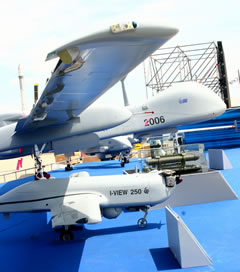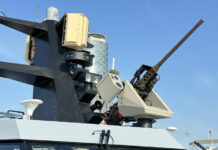As the technology of unmanned aerial systems matures, more systems are reaching advanced stages of development, from miniature aircraft like the Aerovironment Wasp III to the giant High Altitude, Long Endurance (HALE) Global Hawk, produced by Northrop Grumman. Both have already reached operational status with US forces. 
As an operationally proven system, Global Hawk is finding new markets in Europe and Australia. The Germans are planning to operate a derivative of this unmanned aircraft, modified into an electronic support (ELINT) platform. The aircraft is expected to provide the unmanned component of the future European Advanced Ground Sensor (AGS) – an array of manned and unmanned SAR-equipped platforms supporting NATO forces with wide area monitoring and targeting capability. Another HALE concept is being studied by Boeing’s Advanced Systems (Phantom Works). This vehicle is designed to meet future requirements for persistent battlefield ISR, homeland security and telecommunications.
The vehicle will be built of lightweight structures and powered by reciprocating engines consuming hydrogen fuel. The “HALE UAS” will be designed to carry multiple payloads weighing up to one ton (2,000 pounds). The low specific weight and high energetic value of liquid hydrogen will offer significant advantages for extended missions which could last over a week. Boeing also studies power generation by solar cell systems, produced by its subsidiary Spectrolab. By 2009, the company plans to offer space solar cells with efficiencies as high as 33 percent. These cells are five times more efficient than the solar arrays used to propel the Helios UAV and could provide a primary power sustaining an airborne platform for near unlimited mission duration.
 Medium Altitude Long Endurance (MALE) unmanned systems are is becoming the hot topics among the military and government circles worldwide, providing users in the air forces, navies and ground forces a persistent, dependable aerial platform relieved from the constraints associated with humans on board. The growing interest in MALE was reflected by many new programs, introduced here for the first time, most of them as models. One of the models was this jet powered MALE UAV developed by the Chinese company AVIC I. A surprising exhibit was unveiled by the Chinese company AVIC I, showing two model versions of unmanned systems, a jet powered High Altitude Long Endurance (MALE) platform and a fast recce super-drone called DarkSword.
Medium Altitude Long Endurance (MALE) unmanned systems are is becoming the hot topics among the military and government circles worldwide, providing users in the air forces, navies and ground forces a persistent, dependable aerial platform relieved from the constraints associated with humans on board. The growing interest in MALE was reflected by many new programs, introduced here for the first time, most of them as models. One of the models was this jet powered MALE UAV developed by the Chinese company AVIC I. A surprising exhibit was unveiled by the Chinese company AVIC I, showing two model versions of unmanned systems, a jet powered High Altitude Long Endurance (MALE) platform and a fast recce super-drone called DarkSword.
Many of the European air forces have recently expressed their strong interest in acquiring unmanned MALE systems, to support military operations as part of coalition forces (such as in Afghanistan), cope with homeland security, and control illegal immigration. By the year 2015, European countries are planning to field as many as 50 MALE UAVs in France, Italy, Spain, Germany, Finland and Sweden to name only a few. One of the first European programs was the Euro-MALE which followed the basic framework of the Heron TP, developed by EADS and IAI, under a Franco-German-Dutch cooperation. This program has been suspended, and, most recently, the Dutch parliament cancelled the funding for another MALE acquisition – the Predator B (Reaper). General Atomics is nothing but idle in its European marketing thrust – after winning the first sales in Italy (RQ-1) and Britain (MQ-9), General Atomics is pursuing the prospects of selling Predator Bs to the German Air Force. As mentioned above, defense budget cuts in the Netherlands have shelved the Dutch plans to field Predator B. The company is eyeing potential orders for a naval version, known as ‘Mariner’, from the US and Australian Navies as well as a German Air Force requirement for a land-based system.
 Following the cancellation of the original program, Euro-MALE EADS is now pursuing a different path of a modular “Advanced UAV” turbofan powered platform, based on the Barracuda experimental UAV. This airplane could be a possible MALE candidate for endorsement by the European Commission. France and Germany are already discussing this joint development initiative with Spain expected to join soon. A competing design could be another European MALE team, formed by Alenia, Dassault and Saab – these partners are already pursuing the nEUROn unmanned combat aircraft (UCAV) demonstrator.
Following the cancellation of the original program, Euro-MALE EADS is now pursuing a different path of a modular “Advanced UAV” turbofan powered platform, based on the Barracuda experimental UAV. This airplane could be a possible MALE candidate for endorsement by the European Commission. France and Germany are already discussing this joint development initiative with Spain expected to join soon. A competing design could be another European MALE team, formed by Alenia, Dassault and Saab – these partners are already pursuing the nEUROn unmanned combat aircraft (UCAV) demonstrator.  However, each of the team members is already engaged with other commitments. Alenia Aeronautica is busy with its Sky-Y MALE concept vehicle, which is also proposed as the baseline platform for the team. Dassault is interested in continued cooperation with the Israelis, on Heron follow-on platforms as well as the F-355 license-produced UAV, based on the Thales/Elbit Systems Watchkeeper / Hermes 450 platform. This system is being considered as a replacement of the tactical UAVs currently deployed with the French Army.
However, each of the team members is already engaged with other commitments. Alenia Aeronautica is busy with its Sky-Y MALE concept vehicle, which is also proposed as the baseline platform for the team. Dassault is interested in continued cooperation with the Israelis, on Heron follow-on platforms as well as the F-355 license-produced UAV, based on the Thales/Elbit Systems Watchkeeper / Hermes 450 platform. This system is being considered as a replacement of the tactical UAVs currently deployed with the French Army.

The USAF MQ-1A Predator from the 432 TFW was presented at the static display in Le Bourget as part of the static display brought in by the US Department of Defense. This year the USAF displayed the Predator in its standard ‘armed UAV’ configuration, equipped with the MTS stabilized EO turret, datalinks and two Hellfire missiles. On missions, Predators are controlled by USAF pilots from the USA via satellite link. The recce they collect is sent to the US for analysis and interpretation, while real-time images are also available for use by ground units equipped with Rover terminals.
Just before the airshow General Atomics flew its latest Predator variant, the new Sky Warrior for the first flight. The new design will carry an electro-optical/infrared sensors plus synthetic aperture radar (SAR). Sky Warrior will be able to fly longer and higher than Predator, cleared to fly above an altitude of 29,000ft (8,850m). Compared to its predecessor, it uses extended wings and increased internal bay doubling the payload capacity, allowing for carriage of up to four Hellfire missiles in addition to standard mission systems. General Atomics plans to deploy the first batch of production aircraft (Block 0) to the southwest Asia in early 2008 to demonstrate its capabilities and support coalition forces in theatre. The Sky Warrior is equipped with Heavy Fuel Engine (HFE) accepting either jet or diesel fuel. The new model will act in the long-endurance surveillance, communications relay and tactical strike roles.
Among the new faces (at least in model size) was a Turkish MALE UAV developed by Turkish Aerospace Industries (TAI). The ambitious Turkish “Indigenous Medium Altitude Long Endurance” program calls for the development and production of three prototypes within 40 months, addressing specific Turkish Air Force requirements. Meanwhile, Turkey acquired Heron UAVs form Israel Aerospace Industries, to support immediate air force, army and naval operations.

 A new experimental UAV developed by Alenia Aeronautica was unveiled at the show – this is a second member of the “Sky” platform, designed to demonstrate Medium Altitude, Long Endurance missions, particularly large area aerial surveillance missions. The new platform dubbed “Sky-Y” will demonstrate and test critical technologies required for future MALE UAVs, including propulsion, surveillance and reconnaissance sensors, data-links and data-processing systems. These technologies are targeted for use with Alenia’s future MALE platform known as the dual-engine Molynx MALE UAV. Molynx, a new air vehicle under development at Alenia Aeronautica, is designed specifically for land surveillance and civil protection roles. Another MALE platform, also under development at Alenia, is aimed at military applications, of a class similar or higher than the General Atomics’ Predator B and IAI/MALAT Heron TP.
A new experimental UAV developed by Alenia Aeronautica was unveiled at the show – this is a second member of the “Sky” platform, designed to demonstrate Medium Altitude, Long Endurance missions, particularly large area aerial surveillance missions. The new platform dubbed “Sky-Y” will demonstrate and test critical technologies required for future MALE UAVs, including propulsion, surveillance and reconnaissance sensors, data-links and data-processing systems. These technologies are targeted for use with Alenia’s future MALE platform known as the dual-engine Molynx MALE UAV. Molynx, a new air vehicle under development at Alenia Aeronautica, is designed specifically for land surveillance and civil protection roles. Another MALE platform, also under development at Alenia, is aimed at military applications, of a class similar or higher than the General Atomics’ Predator B and IAI/MALAT Heron TP.

Israel unveiled two new unmanned aircraft designed for long endurance missions. MALAT, IAI’s Unmanned Systems Division introduced the Heron TP Medium Altitude Long Endurance MALE UAV Platform, developed for the Israel Air Force and for export. Elbit Systems introduced the Hermes 900, the latest member of the Hermes family of UAVs. Eitan, a potential competitor to the Predator B also made its debut at the airshow. Eitan (also known as Heron TP) is the largest UAV ever built in Israel. It is designed to operate at altitudes up to 45,000 ft, on missions extending beyond 36 hours, carrying mission payloads of up to one ton. In the future, Eitan could be equipped with aerial refueling receptacles and fuel offloading systems to perform ‘buddy refueling’ between two UAVs, therefore extending the platforms mission endurance to very long duration. The IAI/Heron, also displayed here, represented another version of an operational system, as operated by the Indian and Israeli Air Forces, as a multi-payload MALE platform. The Heron commonly uses two EO payloads and additional n COMINT, ELINT and SIGINT systems. The platform can also replace one of the EO turrets, clearing space for a maritime search radar or SAR.

Another Heron derivative, the French SDIM was also on displayed at the EADS static park. SDIM (Temporary MALE system) has just completed a full test campaign at the French MOD test flight center. The French Air Force acquired three air vehicles. The tests included 18 flights logging over 100 hours, conducted by two drones between October 2006 and March 2007. The French Air Force is scheduled to take delivery of the new system by early 2008. By 2014 France is planning to field a follow-on MALE system, to be based on a new platform developed under cooperation with Germany and Sweden.
The Watchkeeper UAV built by Elbit Systems and Thales for the British forces is also maturing. In recent months, the WK-450 (now designated Hermes 450B) was reshaped to accommodate specific British requirements. Its fuselage diameter grew by 30 cm, allowing more space and payload capacity adding 200 pounds for more fuel and systems. The WK-450 was displayed at the Thales outdoor exhibit, where visitors could also see the ground control segment. Some of the advanced applications developed for the system were also displayed. Elbit Systems also unveiled Hermes’s big brother – the new Hermes 900. It is currently under development, with first flight expected in late 2007.
 Designed as a top tier tactical UAV, Hermes 900 will assume many of the missions of MALE platforms, while retaining the ground support and commonality of current Hermes tactical UAV units. With a typical payload capacity of 300 kg, Hermes 900 can easily carry multiple payloads as well as external stores. Elbit did not elaborate on the types of such stores, but among the items that could be considered are suitable guided weapons, cargo dispensers or air-deployable mini UAVs (a concept first utilized by the Finder UAV).
Designed as a top tier tactical UAV, Hermes 900 will assume many of the missions of MALE platforms, while retaining the ground support and commonality of current Hermes tactical UAV units. With a typical payload capacity of 300 kg, Hermes 900 can easily carry multiple payloads as well as external stores. Elbit did not elaborate on the types of such stores, but among the items that could be considered are suitable guided weapons, cargo dispensers or air-deployable mini UAVs (a concept first utilized by the Finder UAV).
A new tactical UAV is emerging from Switzerland – the Super Ranger, a growth version of the Ranger short range UAV designed by RUAG, in cooperation with IAI. Considerably larger than its predecessor, Super Ranger can accommodate multiple payloads, offering enhanced mission capability and endurance. The airframe is fitted with retractable landing gear and meets the new international UAV Systems Air Worthiness Requirements, ensuring the systems can fly safely over populated areas.
 Making its international debut at the airshow was the SpyHawk, from MTC. The lightweight UAV is currently flying as a test-bed by the US Marine Corps, used for advanced technology evaluation. Lessons learned through these flights will be used to
Making its international debut at the airshow was the SpyHawk, from MTC. The lightweight UAV is currently flying as a test-bed by the US Marine Corps, used for advanced technology evaluation. Lessons learned through these flights will be used to  define the next phase of the Corps’ Tier II UAV program, The US Navy is expected to issue request for proposals for tactical (Tier II) UAVs before the end of 2007.
define the next phase of the Corps’ Tier II UAV program, The US Navy is expected to issue request for proposals for tactical (Tier II) UAVs before the end of 2007.
Another new arrival here was the first Mexican UAV developed by Hydra Technologies, in development since 2002. According to company sources, the current version (S4 Ehecatl) is ready for production and initial orders (probably from the department of national defense) are expected this year. The UAV is expected to assume border surveillance and counter narcotics missions. The drone has a wing span of 3.7m (12ft) and has a Maximum TakeOff Weigt of 55kg (120lb), including a 9kg (20lb) payload. It can soar up to an altitude of 15,000 ft and maintain mission endurance of 8 hours, cruising at 38 knots. (Maximum speed is 90kt).
 IAI displayed two members of its new I-View family of tactical UAVs, developed to operate as an organic asset at Army Division level and below. The larger I-View 250 and the smallest version, the I-View 50 were on display. Autonomously operated from a single HMMWV which also carries the launcher, ground support element and container, it is particularly suitable for the Brigade level. IAI offers three configurations of the system, designed for different payloads weights and mission performance levels. All models use common systems and field support. The launch customer of the I-View system was Australia, which will get its first I-View 250 systems within 2- 3 years. I-View is currently competing on other tactical UAV acquisition programs including the Israel Defence Forces Small UAV program, which calls for the deployment of tactical UAVs at brigade level. Elbit Systems is offering the Skylark II Small UAV system for the same IDF program. The Skylark II’s main advantage is in its capability to fly covert missions at low to medium altitude, in day, night, and under low clouds, when other observations systems are limited by poor visibility.
IAI displayed two members of its new I-View family of tactical UAVs, developed to operate as an organic asset at Army Division level and below. The larger I-View 250 and the smallest version, the I-View 50 were on display. Autonomously operated from a single HMMWV which also carries the launcher, ground support element and container, it is particularly suitable for the Brigade level. IAI offers three configurations of the system, designed for different payloads weights and mission performance levels. All models use common systems and field support. The launch customer of the I-View system was Australia, which will get its first I-View 250 systems within 2- 3 years. I-View is currently competing on other tactical UAV acquisition programs including the Israel Defence Forces Small UAV program, which calls for the deployment of tactical UAVs at brigade level. Elbit Systems is offering the Skylark II Small UAV system for the same IDF program. The Skylark II’s main advantage is in its capability to fly covert missions at low to medium altitude, in day, night, and under low clouds, when other observations systems are limited by poor visibility.
Mini-UAVs were among the surprises of the recent conflict in Lebanon. These small and low-cost systems demonstrated excellent performance, they were most adaptable to the user’s needs, and operating at almost total silence they were virtually invisible even in daylight. Furthermore, these UAVs are the only platform capable of delivering imagery ‘below the clouds’, under weather conditions that hinder the operation of larger UAVs that operate above the clouds level. The Israelis operated two types of mini-UAVs, the Skylark I developed by Elbit Systems and the RAFAEL Skylite B, developed and operated by RAFAEL.















